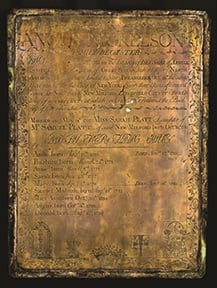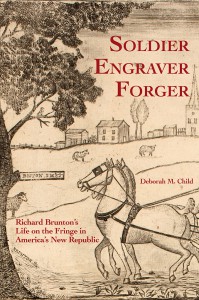So read the words atop a family record engraved by Richard Brunton in the early 1800s. It is that admonition, which speaks directly to the NEHGS purpose, that led us to have an interest in Brunton – now the subject of a new book written by art historian Deborah M. Child: Soldier, Engraver, Forger: Richard Brunton’s Life on the Fringe in America’s New Republic.
Over the centuries, families have kept records of their history: in pen and ink, in needlework, and now in printed books and in electronic media. Families have kept these “documents” not just as cherished mementos of loved ones, past and present, but also as the “central repository” for the vital records of the family and its members. Richard Brunton – an English soldier who deserted during the American Revolution and made his home in New England – was a trained engraver. During the years when he was traveling throughout New England practicing his craft – sometimes even in the production of counterfeit bank notes – he was, in his own way, at the vanguard of the business of producing family register forms, something that would only increase and become more commercially viable in the following decades.
 Richard Brunton (1749–1832), Angus Nickelson Family Register, circa 1790. Inscribed rlc “R. Brunton, sculp.” Brass, sight 14½ × 11¼ inches. Charles McKew Parr Collection in the Archives of the Magnus Wahlstrom Library, University of Bridgeport, Bridgeport, Connecticut. Photograph by Michael Fredericks.
Richard Brunton (1749–1832), Angus Nickelson Family Register, circa 1790. Inscribed rlc “R. Brunton, sculp.” Brass, sight 14½ × 11¼ inches. Charles McKew Parr Collection in the Archives of the Magnus Wahlstrom Library, University of Bridgeport, Bridgeport, Connecticut. Photograph by Michael Fredericks.
Families for whom Brunton provided registers – as well as memento mori and engraved medallions with names and dates – benefited from having their family information recorded, and genealogists of today benefit from being able to glean information from the artworks he left behind. They provide a view into how our ancestors recorded the vital records of their own families and the importance they placed on “remembering ancestors.” Such artworks give us a legible and tangible record of our loved ones’ existence. If you are lucky enough to have possession of one or more such pieces, you have an intimate window into your ancestors’ lives that censuses, court documents, and other records do not provide.
Brunton himself, ironically, left no record of his own family; he was a man living on the fringe in a young country. In her expert biography of Brunton, Deborah Child has brought an art historian’s skill and a genealogist’s eye to the evidence about him – and, in so doing, gives us a picture of New England life in the early Republic.
This blog post is adapted from the foreword to Deborah M. Child’s Soldier, Engraver, Forger, written by D. Brenton Simons and Penelope L. Stratton. For more information about Richard Brunton, see “Cherished Mementos: Engraving by Richard Brunton from the Earliest Years of the American Republic,” by Deborah Child, American Ancestors 15 (2015): 45–48, available to NEHGS members online. NEHGS will hold a book launch, free and open to the public, and featuring a talk by the author, on Wednesday, June 17, at 6 pm. Registration requested.
Share this:
About Penny Stratton
A veteran of the book publishing industry, Penny Stratton retired as NEHGS Publishing Director in June 2016; she continues to consult with the Society on publications projects. Among the more than 65 titles she managed at NEHGS are The Great Migration Directory, Elements of Genealogical Analysis, Genealogist’s Handbook for New England Research, and the award-winning Descendants of Judge John Lowell of Newburyport, Massachusetts. She has written for American Ancestors magazine and is a regular poster on Vita Brevis. With Henry B. Hoff, Penny is coauthor of Guide to Genealogical Writing: How to Write and Publish Your Family History; she is also the author of several Portable Genealogists on writing and publishing topics.View all posts by Penny Stratton →
